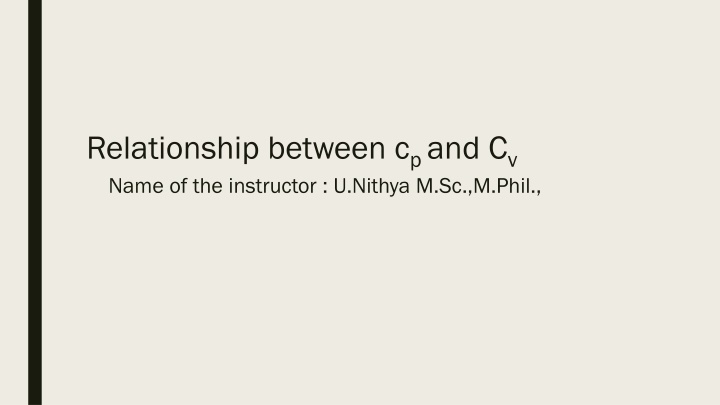
Understanding Molar Heat Capacities in Thermodynamics
Explore the relationship between Cp and Cv in thermodynamics, defined as the heat capacities at constant pressure and volume respectively. Learn about the definitions, calculations, and relationships between enthalpy, internal energy, and temperature changes. Instructor: U. Nithya, M.Sc., M.Phil.
Download Presentation

Please find below an Image/Link to download the presentation.
The content on the website is provided AS IS for your information and personal use only. It may not be sold, licensed, or shared on other websites without obtaining consent from the author. If you encounter any issues during the download, it is possible that the publisher has removed the file from their server.
You are allowed to download the files provided on this website for personal or commercial use, subject to the condition that they are used lawfully. All files are the property of their respective owners.
The content on the website is provided AS IS for your information and personal use only. It may not be sold, licensed, or shared on other websites without obtaining consent from the author.
E N D
Presentation Transcript
Relationship between cp and Cv Name of the instructor : U.Nithya M.Sc.,M.Phil.,
Molar heat capacity of a gas at constant pressure (Cp): Consider enthalpy of a system as a function of pressure and temperature H =f (P,T) Complete differential equation dH = ( H/ p )T dp + ( H/ T)p dT Constant pressure dp =0 dH = ( H/ T)p dT dH = qp qp= ( H/ T)p dT qp/dT = ( H/ T)p= Cp
Definition: cp= qp/ dT The molar heat capacity of agas at constant pressure is defined as the amount of heat required to raise the temperature of one mole of the gas at constant pressure through one degree. Thermodynamic definition : Cp= ( H/ T)p The molar heat capacity of a gas at constant pressure is thermodynamically defined as the rate of change of enthalpy with temperature at constant pressure.
Relationship between H and Cp: ( H/ T)p = Cp Constant Pressure dH. = CpdT Small change H = Cp ( T2-T1)
Molar heat capacity of a gas at constant volume Cv consider internal energy of a system as a function of volume and temperature E = f (V,T ) Complete differential equation dE= ( E/ v )T dv + ( E/ T)vdT. ---------------- 1 First law dE=q-w q-w = dE. ------------------------------------ 2
2 in 1 q-w. = ( E/ v )T dv + ( E/ T)vdT. Constant volume dv=0, w=0 qv= ( E/ T)vdT. qv=( E/ T)v. d T qv/ dT=( E/ T)v. = Cv
Definition: cv= qv/ dT The molar heat capacity of abgas at constant volume is defined as heat required to raise the temperature of one mole of the gas at constant volume through one degree. Thermodynamic definition : Cv= ( E/ T)v The molar heat capacity of a gas at constant volume is thermodynamically defined as the rate of change of internal energy with temperature at constant volume.
Relationship between E and Cv : ( E/ T)v = Cv Constant volume dE = CvdT Small change E = Cv(T2-T1)
Relationship between Cpand Cv E = f (V,T ) Complete differential equation dE= ( E/ T )vdT+ ( E/ v) Tdv dE= CvdT+ ( E/ v )T dv. First law dE = q- Pop dv q = dE + Popdv. ----------------------------- 2 Sub 1in 2 q= CvdT+ ( E/ v )T dv. +Popdv ------------------------- 1 Pop= P for constant. pressure qp= Cv( T)p+( E/ v )T ( v)p+P( v)p
( T )P (q/ T)p= Cv( T/ T)p+ ( E/ v)T( v/ T)p+P ( v/ T)p Cp= Cv+ ( E/ v)T( v/ T)p+P ( v/ T)p Cp- Cv=( E/ v)T( v/ T)p+P ( v/ T)p-------------------------- 3 Cp- Cv=( v/ T)p [( E/ v)T +P]--------------------------- 4 For ideal gas ( E/ v)T = 0. -------------------------- ---------- 5 PV =RT V/T =R/P
Differentiate at cons P ( V/ T)P= R/P --------------------- 6 6in4 Cp- Cv= R/P[( E/ v)T +P] Cp- Cv=R/P[0+P] Cp-Cv= R/P xP Cp- Cv= R
Thank you






















